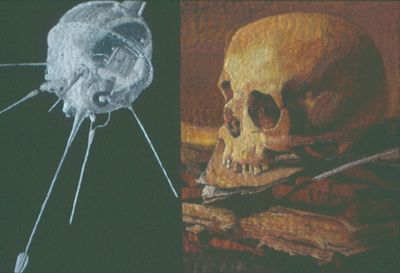Despite the highly specialised technique employed by Anna Hunt in her work, she is adamant that she produces art, not craft. Typically her work consists of meticulously embroidered representations of modernist icons, for example the architecture of Frank Lloyd Wright. Working from photographs, the result is an oddly subversive hybrid, a comment by a friend that the artist appreciates. 'Vanitas' is Latin for vanity and is a type of still life painting representing objects that symbolise the brevity of human life and the transience of earthly pleasures and achievements. These memento mori (literally reminders of death) are typically skulls, mirrors, broken pottery or flowers. By juxtaposing a centuries-old human skull with a modern machine, Hunt suggests that the search for immortality is futile. Needlecraft is a traditional occupation, associated with domesticity and the feminine, in contrast with the public profile of high technology which has more masculine associations. By representing modernist innovation in a low tech medium, Hunt critiques the subject matter. In a world of cheap disposable images, such as magazine photographs, Hunt's anachronistic method of reproduction can be seen as an attempt to recapture the lost aura of the unique image.


